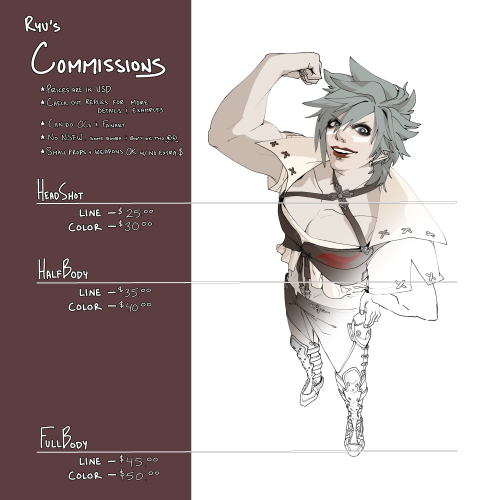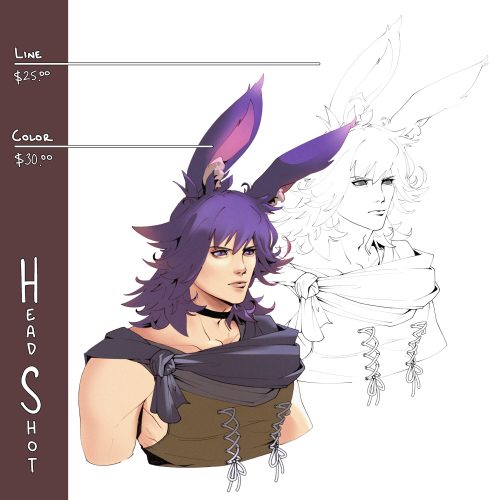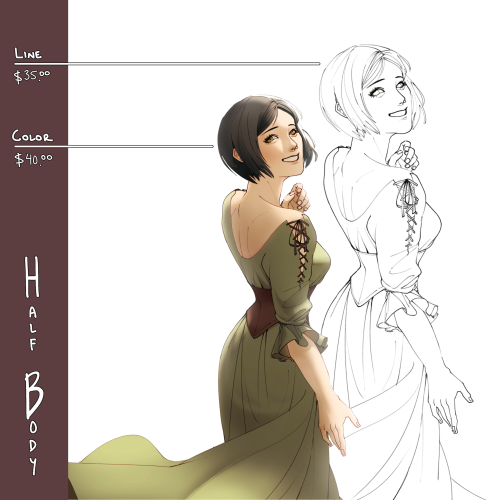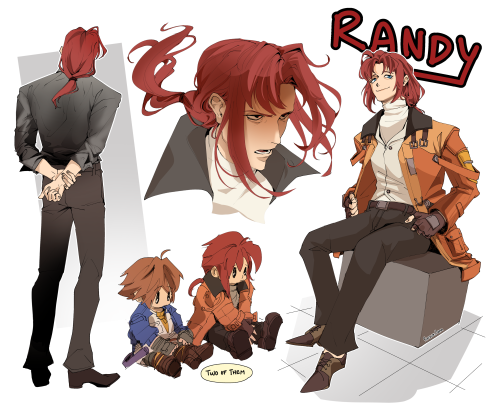#falcom
Ys: The Oath in Felghana
©️ Nihon Falcom 2005
Image sourced from youtube.com/ Vercsase
Last post for the Ys3 retrospective. This is Falcom’s remake of Ys3 for Windows PC, and ported to PSP a couple of years later. Not to be confused with the PS2 remaster by Taito the same year. The character designs are a bit more faithful, but everything else is redone with Falcom’s newer 3D engine.
Post link
Ys III: Wanderers from Ys
© Nihon Falcom 1989
Image sourced from vgmuseum.com
Compare this against how western CRPGs did portraits. Ultima 6 which came a year later and considered one of the best graphics of its peers, had derpier faces than this.
Post link
Hello! Apologies for not being the most active here in a while, but I have a backlog of sketches I hope to share soon~
In the meantime, I’ve opened commissions! Prices and samples are shown here~ If you’re interested in a commission, just DM me and we can work out the details from there!
Post link
“Rally-ho, true believers!” I shout, swinging into the grand hall on a chandelier, interrupting the fancy party. Everything stops as eyes are focused solely on me – on my roguish good looks, my brand-name tabard, my elk leather highboots. I somersault to the floor, landing on my feet with a flourish and a bow. “I know you must have thought this high society gathering dreadfully dull without me here to tell you about the intricacies of composing prose for novel electronic amusements, so I’ve come to enlighten and entertain thee. Also, did you know all the food here is free? My pockets are full of cocktail wieners right now.”
Indeed, it’s an honor to see you again, dear readers. I hope you enjoyed my previous blog about the upcoming PC release of Zwei: The Ilvard Insurrection. As a small refresher, it served as something of an introduction to Zwei: II as a game – what it’s all about, its two main characters, the setup of the story, and its battle and leveling system. You can think of it as a sampler platter to give you a taste of why this game’s cool.
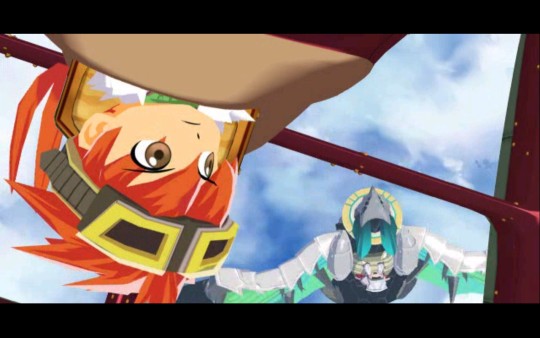
Do a barrel roll
Today, in my second Zwei: II blog, I’d like to go into more detail on the process of writing and editing for the game, and some of the things I dealt with and thought about as I localized it. I’ve done an entry like this for each of my prior projects, and I always enjoy it because it gives me a chance to briefly pull back the curtain and share with you some of the minutiae of localization, and the truism that every project is its own beast.
One interesting thing of note about this project is that it’s the first project on which I served as the sole editor. When I started working at XSEED, most of my prior localization experience had been as part of a team working on large single projects, while most of XSEED’s workflow at that time had been to keep a single editor on a project as much as possible. Each method has its own benefits, as you’d expect. When I work with a partner or team, I enjoy being able to bounce ideas off them or ask for hot takes any time I want, like, “Okay, which of these five potential quest names sounds the best to you?” or “Here’s what I have so far for this scene, but I want this girl to sound more disinterested. How would you do it?” We solicit general impressions from the office fairly regularly, but having other editors acquainted with the specifics and setting of the project you’re working on gives you access to an informed, expanded scope beyond your own intuition and experience. That’s important, because every editor is naturally going to have some characters or scenes they click with more readily than others.
On the other hand, flying solo can also be nice because it represents a purer distillation of editorial voice. With single-editor projects, you know that all the text in the game was overseen by the same person, making thoughtful choices with full knowledge of where everything fits in the greater scheme of the story. I think that’s what XSEED values about this methodology, but with the arrival of mammoth-sized scripts like those for the Story of Seasons and Trails of Cold Steel games, it became a matter of practicality to learn to work well as small teams on projects – a challenge I think our editors have risen to meet in admirable fashion. Of course, that’s not to say I didn’t have a lifeline or two working on Zwei: II. Junpei and Tom were an ever-present source of support whenever I had a question about something in the Japanese – and there were many, many of those over the duration of the project. Even when you’re working alone, you’re never truly alone when you’ve got the office familia backin’ you up.

Getting to work on a project by myself has also helped me better understand my own work process. One nice thing is that everything I mentally bring to a project – the stories I’ve consumed and experiences I’ve had that color how I interpret characters and scenes – remains consistent throughout. This is especially pertinent when writing for comedic scenes, as no two editors will have the exact same sense of humor, and Zwei has more than its share of wisecracks and comedy. The scary thing about being the sole face of a game, though, is that anything that’s weird or wrong, any jokes that totally fall flat, emotional connections that don’t get made – that’s all on me. In a way, it’s a test of myself as a writer and editor, with you all as the judges. With the original Story of Seasons, Tom and Ryan lent me a hand, and I had the dashing Young Kris as my partner for the first Trails of Cold Steel, but here, you get pure Nick, for better or worse (hopefully for better).
I mentioned briefly in my previous blog that Zwei: II felt like it was deeply informed by ’90s anime and manga, and I’d like to unpack that a little more for you here, in case your curiosity was piqued at the notion. After all, a lot of the games we work on here at XSEED are pretty anime-flavored, right? What’s one more on the list?
Here’s my take. Over time, the general vibe of anime has undergone change, as all thriving arts tend to. One major difference – the one most relevant to our discussion – is the observation that protagonists in many modern series tend to be passive, disaffected, reticent, or otherwise hesitant to engage the world and situations around them. They’re the reactive sort. Sometimes it’s because they’re exceptionally socially aware. Sometimes it may be because they’re awkward youths. Sometimes it’s because you get the impression that the writer really wants you to think this person is cool or above it all. Anime from the ’90s, on the other hand, is much more associated with protagonists who leap into situations without thinking, do things without considering the ramifications of their actions, and adhere to a personal code or philosophy that the character consciously or unconsciously holds. Both approaches, in the hands of a good storyteller, can and have made for some great entertainment, but from a writing perspective, the “’90s anime” types are definitely easier for me to work with. They’re more expressive, more willing to engage, and their very being tends to create conflicts that help drive the story and the growth of both themselves and other characters.

During the time I was working on Zwei: II, I actually ended up rewatching a season of Ranma ½ (those blu-rays are preeeeetty sweet) and seeing the Tenchi Muyo TV series for the first time (on loan from Tom). Seeing those really made this whole point click with me, like, “…That’s it! That’s the kind of comedic stylings Zwei is trying to channel!” Not in the sense of specific plot points or characters from any particular series, but the sort of atmosphere that was about creating opportunities for amusing things to happen. Ranma, for instance, tends to nettle many of the characters in his series not on purpose, but just by being who he is. And not just that – doing it on purpose also comes very easily to him (just watch how he loves to bait Ryoga or Kuno with his taunting). Ragna is less purposefully ornery, but his decisive personality draws the admiration of some and the exasperation of others. Plus, later on in the game, you run across a genuine hot spring, and we all know what a staple of the era that is. ;)
You’ve probably heard the saying, “Tragedy is easy, comedy is hard,” and there’s truth in it. Most of us love a good comedy, but do any two of us love all the same comedies or laugh at all the same things? Humor is deceptively difficult because it’s so mercurial, influenced by the times, by moods, by delivery, and more. A bit that might leave you stone-faced Monday night could have you busting a gut Thursday night. Understanding why something that makes you laugh does so is the study of a lifetime. There’s really no shortcutting it – you have to get the mileage, experiencing things that make you laugh, thinking about why, and chasing the next thing you think might give you another shot of mirth. I can only hope that I’ve imbibed enough of the spirit of humor to properly convey the charm of what is perhaps Falcom’s most levity-laden title.
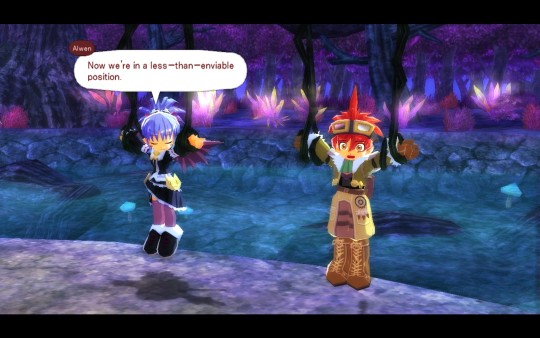
Yeah…just hangin’ in there, y'know…
Beyond my approach to the game itself, we have its characters – the heart and soul of the action. Quite often, early on in the process of localizing a game, I’ll get an impression of a character as, “Oh…I guess he’s a lot like X from [other source],” and as I make a couple of those anchoring connections and begin considering the characters in the game from those perspectives, they begin to show their multiple facets. Lest you think this sounds too close to, “Oh no, he’s just taking an existing character and foisting that persona on this carefully crafted, unique game character!”, take a measure of comfort in my assurance that I, too, would be dissatisfied with an approach that oversimplified. Think of it more as a basic framework – scaffolding that lets me clamber around the object d’art to get at the fine detailing.
With Ragna, for instance, his characterization is very front-loaded in the game. Right away, you know he’s a freewheeling pilot, sort of a hotshot, and likes to do things his own way. The image he creates is very “early 20th-century flyboy,” and I sort of conceptualized him as a guy who wouldn’t feel out of place if you stuck him in among the cast of “The Rocketeer.” Speech-wise, his alternating between laid back and fired up reminded me of Gundam Wing’s Duo Maxwell, and like that character, Ragna likes to chime in with some tongue-in-cheek commentary if something patently ludicrous or weird happens in the game. Finding characters who are reasonably like the one you’re writing for helps, as does understanding the milieu in which a character exists – what they were doing just before the story began, and what the world around them that shaped them is like.

There are actually a couple characters who have what I termed “Ragna-variant” speaking styles. Ragna’s main vocal tic is that he sometimes truncates words ending in “-ing” (so “nothing” would become “nothin’,” and “fighting” would be “fightin’,” though I tried to generally keep it to one per text box – it’s a spice, not a marinade), so among the expanded cast, you get some people who speak that way because they have similar lifestyles. Odessa, as a rough-and-tumble Treasure Hunter who specializes in capturing bounties, is very colloquial in her faux old-west style. Gashler, who runs the garage out by the airstrip, is a full-bearded, goggled mechanic that sort of reminded me of Cid from Final Fantasy IV, and his speaking style is pretty thick – one of the most affected in the game, though I tried to make it still pretty easy to comprehend. One also has to consider that people who have special styles of speech have certain occasions where that’s either suppressed somewhat, or is expressed with even greater emphasis than normal. Even old man Gashler might speak (mostly) standard English if you dragged him to a black-tie event, but on the other hand, if someone said his workmanship is rubbish, I have no doubt that he’d be cussin’ up a storm, blastin’ furnace-fire, and lettin’ loose with the sort of strange, idiomatic expressions that only grease-stained mechanics know.
Ragna being an unusually “American-feeling” character made him pretty easy to write for right from the start. Alwen took a little more finesse and more time to find her ground – but not because she was difficult in a conventional sense. The trick with Alwen was that she definitely inhabits a certain archetype, at least partially, but I needed to figure out how much of that I needed to accurately represent her, and when to let her individual characteristics shine.
Alwen, as the daughter of an esteemed Trueblood vampire house, can be very prideful, bordering sometimes on haughty. She learns fairly quickly that the world beyond her castle has more complexities than she gave it credit for, but her distance from the world of humans actually gives her some surprising insights. Now, the most common way you see characters like Alwen played are that they step out into the greater world, eventually realize how much they don’t know, and depend on their friends to teach them what it means to really live along the way. Alwen…has some of that, but it’s the way she interfaces with the world that makes her an interesting and fun character. For example, she doesn’t technically NEED to eat food, but likes eating a ton of it (on Ragna’s dime, of course) just because it’s tasty. She’s not afraid to walk right into town and make small talk with the people. Alwen may be a vampire, but she’s refreshingly (and oddly) free of so many of the preconceived expectations people have about what vampires are like. She even calls Ragna out on this early on in the game when he’s shocked that she walks around just fine in the bright morning sunlight. A great deal of Zwei: II’s story is really her story, especially when it comes to getting the ball rolling, and it helps the story greatly to have a character who both entices with a bit of the familiar but also stands out due to individual quirks.

I also did with Alwen a variant of what I did for Laura in Trails of Cold Steel, where I shifted her from talking with a “proper,” antiquated style of speech to a more natural speaking style that still retains the idea that she’s highborn. Coming at this from a lore perspective, Alwen hasn’t been out of her castle in the last 100 years or so and has learned what she knows of the world from her estate’s extensive library, so it would be very feasible for her speaking style to sound older than that of Ragna or the people of Artte. In practice, though, Ragna having a casual style of speech and Alwen’s speech being fairly rigid made it difficult for the comedy to land, and to really connect with Alwen as a character. Can you imagine what Star Wars would’ve been like if Princess Leia spoke like a medieval fantasy princess while trying to banter with Han Solo? That’s the kind of disparity I’m talking about. It might’ve been funny, but for reasons entirely unintended. So after thinking on it a while, I decided to adjust Alwen’s speaking style, dialing it back. My priority was to keep her sounding articulate and well spoken, but casual up the language so that the banter between her and Ragna has the requisite snap it ought to. In my opinion, the net gain from that was well worth the adjustment, which you’ll be able to see for yourself when you play.
Sort of tangentially related to that, in the Japanese version, Ragna goes through basically the whole game calling Alwen “Princess” (“hime-san”). The best reasoning I could figure is that maybe, having taken on some power from their blood contract, Ragna feels he should acknowledge her as his liege, but…that explanation totally flies in the face of Ragna’s personality. Ragna is a guy for whom there is ONLY a first-name basis (or a nickname if he finds one for you he likes). The most likely explanation is that it’s just the difference between politeness levels in Japanese personal address versus Western personal address, but the title put a certain amount of “distance” between them that I didn’t want to remain there for the duration of the game. The alteration I made to compensate for this was to have Ragna refer to Alwen as “princess” a bit at the very outset of the game, but quickly fall into using her first name, which feels much more natural for the character. To draw the analogy with Star Wars again, think of it as Han Solo going from calling Leia “princess” or “your worship” in a sort of snarky context when he doesn’t really know her to simply calling her “Leia” once he’s spent time with her and knows her as an individual. Plus, with as big a deal as Ragna makes over wanting to work together with Alwen as “equal partners” at the start of the game, it would be weird for him to then go on to refer to her by her royal title for the rest of the game.
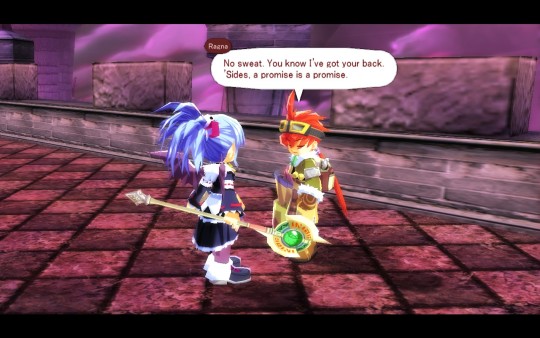
This discussion isn’t meant to be a comprehensive retrospective of Zwei: II’s localization, of course; just a list of some of the noteworthy things I grappled with working on the game. Editorial work does have its pressures and difficulties – when the buck basically stops with you, how do you know you’re making the right call? – but ultimately, these kinds of challenges are what keep the job fresh and interesting. The point of all the character personality profiling, the speech styles, the fine-tuning, is for players to be able to sit down and experience a fun story and memorable characters that “just work,” no speculative microscope examinations of the translation required. I think my obsessive tweaking and spit-polishing will make for a better game experience…but you don’t have to take MY word for it. Give Zwei: The Ilvard Insurrection a try when it comes out and see for yourself!
Excelsior, true believers! Nick here again, penning these gladsome tidings from my grand scriptorium full of musty scrolls and ancient cartridges. Alas, it’s been quite a while since I checked in with all of you – well over a year, in fact, with the release of the first Trails of Cold Steel. With that giant title now roaming free in the wild like the majestic brachiosaurs in Jurassic Park, you may have wondered what I’ve been working on over the course of the last year. It always seems to unintentionally happen that I get assigned to projects I can’t talk about for significant lengths of time, but this stretch has easily been the longest. So many times I’ve wanted to tell you some quirky story or fun little side-note about this game as I worked through its script, but alas, the official XSEED duct tape was covering my mouth – until very recently, that is.
In our yearly lead-up to the gaming extravaganza that is E3, we finally announced my long-in-coming project: the classic Falcom action RPG Zwei 2, making its debut outside of Japan as Zwei: The Ilvard Insurrection!

Of course, I’ve also helped out with a variety of other, more time-sensitive projects, leading to Zwei taking a bit longer to bring to you than it would have otherwise, but I think we’ve got something you’ll really enjoy in the making here. And conveniently, the benefit of the slow going is that the release isn’t too far off now. As Zwei II enters its final stretch before release, I wanted to tell you more about the game – which is exactly what I’ll do, over the course of the next couple weeks.
Zwei II has an interesting history: released in 2008, it was the very last game Falcom developed exclusively for PC. Back then, the PC gaming market was far from being the robust, thriving scene we know it as today, especially the Japanese market. Thus, the title seemed almost fated to fly under the radar despite its quality craftsmanship and hours of fun. But now, with the worldwide PC game market booming and digital storefronts ensuring copies can get into the hands of anyone who wants to play, it felt like the right time to fill this conspicuous gap in Falcom’s lineage.
“But…what about the first Zwei?” you may be pondering aloud to your monitor. If you’re wondering whether you’ll be at a disadvantage playing the second game in the series before the first, worry not! I’ve played both (thanks to Tom’s Japanese boxed copies) and can confirm that Zwei II gives you all the info you need to understand the world, its plot, and its characters. There was a 7-year gap between the first and second Zwei games in Japan, and Falcom couldn’t assume players would’ve played the earlier entry, so the structure is something more akin to Trails in the Sky versus Trails of Cold Steel, where the games take place in the same world, but in different locations and with different casts. This makes it easy to jump right in.
To start things off, I wanted to sit down and flesh out the game a little for you, since compared to its siblings in the Ys series, and even Xanadu, it’s far less known by fans. What is the Zwei series? What makes it great? How does it play? Why is it cool?

Let’s start from the ground up: the name of the game. “Zwei” is simply the German word for “two” and, as you’ll soon discover, it’s a very fitting title – the game features not one, but two protagonists. Our leads in Zwei II are Ragna Valentine, a lively treasure hunter and pilot-for-hire, and Alwen du Moonbria, a confident vampire princess looking to avenge herself against an unknown enemy. How these two very different people meet and come to really understand (and maybe even appreciate) each other is the relationship that forms the heart of the game, and I’ve done my best to make that journey of growth and understanding a fun and memorable one. And, as with any good RPG, the journey is not without obstacles to overcome. Fortunately, our hero and heroine are up to the task, with Ragna skilled at mixing it up in melee, and Alwen versed in the ways of magic. You can swap between them at any time, and whoever you’re not controlling runs along behind you, ready to leap into the lead role at the press of a button.
Zwei II’s combat is action-based, not unlike the Ys games or Gurumin, but the two-character setup creates an interesting dynamic in combat. Over the course of the game, Ragna will be able to upgrade his weapon, the half chain-whip/half katar Anchor Gear, into several different forms, and Alwen (who begins the game bereft of most of her magic) will regain her powerful spells. You end up being able to do some interesting things, like using a claw-variant of Ragna’s Anchor Gear to grab an enemy, then throw it into another enemy, knocking both into a corner, then swapping to Alwen and unloading a fiery salvo on them. Or have Alwen cast her whirlwind magic to sweep up a couple enemies and keep them stun-locked, then swap to Ragna to leap into the air and string together a midair combo on them. In many dungeons, I often found myself favoring one or the other to take the lead because of the strategies I came up with to best deal with certain types of enemies, and you’ll likely fall into styles of play that fit the way you prefer to approach the game’s combat as well.

And speaking of approaches to combat, Zwei II has a rather unique leveling system, too. In the game, you don’t earn EXP from quests, or from beating up monsters. You actually earn it by eating food – the same food you use to heal yourself when you’re running low on HP. There’s even a “food exchange” service available at the restaurant in the main village of Artte that lets you trade 10 of any one type of food for one of another type that gives more EXP than the ten individual pieces of food would have if eaten on their own (example: trade 10 cheeses worth 10 EXP each for a single pizza worth 150 EXP). Will you chow down now, or hoard in the hopes of cashing in for savory plates of EXP-rich cuisine? You decide! It probably sounds weird (it certainly did to me when I first learned about it), but in practice, it actually works really well. It frees you up from having to grind in dungeons, or feel like you absolutely MUST kill every enemy on the way to your destination. It also gives you a lot of control over your own challenge level. When I was playing the Japanese version of the game, my loose rule was that I’d never eat food just to level – I’d just use it when I was hurt, to restore HP. I ended up going through most of the game under-leveled because of this, but never TOO under-leveled, because the more under-leveled I was, the more damage I’d take, thus getting infusions of EXP more frequently from using food to heal myself. There’s a strange sort of balance to it, and the game isn’t stingy about giving you food in chests, as drops from enemies, and even from giant slot machines you’ll find in each dungeon, so you can decide whether you want to blow through the game as a force of nature but with less on-demand healing available, or a bit underpowered but with a fully-stocked pantry.
If that talk of slot machines that dispense food or trading wedges of cheese for a pizza sounds a little…weird, that’s by design. More than any Falcom game I can think of, the Zwei series embraces its sense of humor, poking in good-spirited fun at its two main characters, the townspeople, and even many of the foes you face down along the way. It’s got a lively, colorful, and cartoonish art style that has helped the graphics hold up well, too. You probably know from personal experience that stories more focused on being comedic sometimes run the risk of not being able to successfully shift into a more serious mode when the story calls for it, but thankfully, Zwei II doesn’t suffer from this issue. It’s surprisingly adept at conveying a serious atmosphere when the story calls for it, making for some excellent dramatic moments, and even a dab of pathos here and there. But on the whole, Zwei II is a game that feels deeply informed by 90s anime and manga, with all the oddness and charm that comes with that. I can certainly say that being rooted in that style proved fertile ground for my work to help the game achieve its comedic potential (speaking as a weeb from ancient times), and I’m already planning my next blog post to focus on some of the details of the writing and the characters.
One thing I love about Zwei II is that it reaches out and really grabs you from the start. In just the first 20-30 minutes, you get the following ace setup (obviously, skip these next two paragraphs if you want to go in totally blind):
The game begins in the skies, as courier pilot Ragna Valentine is cruising in his cool red biplane, the Tristan, toward the island of Ilvard on a routine delivery mission. Suddenly, he’s ambushed by unknown assailants, and after a dogfight against a pair of dragon-riders in the skies over Ilvard, his plane takes a bad hit and plummets toward the land below. The next thing he knows, he wakes up in a bed in the nearby town of Artte as the town doctor marvels at how he came out of such a crushing impact with barely a scratch. After all, his plane didn’t fare nearly as well. Going out to investigate the crash site, Ragna finds his plane on a hill on the outskirts of town, busted up and snapped in half just as the doctor said. So how did he even survive such a nasty crash?

Well…he almost didn’t. After that crash, as he lay among the wreckage, broken of body and bleeding out, he was rescued from his mortal fate by none other than Princess Alwen du Moonbria. Alwen isn’t your ordinary RPG princess, though: she’s a sharp-tongued shut-in vampire princess. Not too long before the start of the story, Alwen’s castle was invaded by a mysterious foe who ultimately seized the stronghold and gave her the boot, after stripping her of her ancestral magic. Seeing the outsider Ragna as her best bet to help her search for her magic and retake her castle, she takes some of his blood and gives him some of hers, sealing a pact that turns him into her ‘Blood Knight’ – a warrior in thrall to a powerful Trueblood vampire whose physical abilities and regenerative capacity far exceed what humans are capable of. But Ragna, see, is all about freedom and doing things his way, and he hates the idea of working as anyone’s lackey. After realizing the situation he’s in, though, he strikes a deal with Alwen: he’ll help her get her castle back as thanks for saving his life…but instead of being master and servant, they’ll do it as equals.
And so, our story begins.
Cool, right? And that all happens in fairly short order – no longwinded tutorials, no hours of quests before the gears really start to spin. Zwei II has a lot of heart and a lot of dialogue, and to its credit, it seldom feels like it drags. The story starts with a bang and keeps things moving at a good clip.
That’s not to say there isn’t plenty to do, though. The island of Ilvard is dotted with thriving communities and, in the fashion of the Trails or Ys games, they’re populated with fleshed-out NPCs who have their own small story arcs and conflicts to overcome over the course of the game, with dialogue that changes frequently after progressing the main story. Some of the residents are funny, some are petulant, and some are just downright strange, so I hope you enjoy getting to know all of them over the many times you’ll visit the towns. You might even stumble upon unique scenes, a secret hint, or a good ol’ fashioned RPG quest (you know, the kind from back before there were convenient quest logs to keep track of things). And of course, what with Zwei II being focused on Ragna and Alwen as dual protagonists, they’ll often have unique things to say in response to other characters depending on whom you’ve got in the lead.

In the course of working on the game’s script, I observed with no small amount of fascination that in some ways, it almost seems like Zwei II was made more with Westerners in mind than the Japanese market. Ragna himself is an incredibly un-Japanese character, with his bravado, easygoing swagger, and sass, but he’s a character that I know will click instantly with the North American audience in particular. We see Ragnas in our books and films; we all probably know someone like him, or who has elements of his personality. Alwen, too, is a character I think will be well-liked by the West. Not content to lament the loss of her home or sit idly by, she picks herself up and decides to get even and take back everything that was taken from her even though it promises to be an uphill battle. The core of her personality is her self-assured nature – even when confronting a world she’s mainly just read about (in books that were, sadly, out of date on the latest trends and customs). Quick-witted and keen, she matches Ragna tit-for-tat, helping the two play well off each other. Beyond just them, there’s the wild west-flavored bounty hunter Odessa, chain-smoking nun Isabella, the worldly jazz pianist Shester, dependable engineer Miriam, and of course, the irrepressible luchador-masked man of mystery, Gallandeau, among many others. Having a zany cast of characters like this all together in one place feels like the kind of storytelling we enjoy so much in Japanese games. But at the same time, after seeing so many forgettably milquetoast light novel-style characters in the games and anime of recent years, it’s refreshing to come upon a game where the characters have an abundance of personality – where I know they’ll resonate with the audience I’m localizing the game for.

So…there you go. In a nutshell, this and more is what you have to look forward to when Zwei: The Ilvard Insurrection finally makes its debut. Like a time capsule laden with the charms of a bygone era of RPGs, I think it’ll prove its worth to you as more than simply a pleasant surprise – I think it has the merit to stand proudly as one of Falcom’s finest.

So, are you all enjoying Ys: Memories of Celceta on PC? YOU DID BUY IT, DIDN’T YOU? DIIIIDN’T YOU?! …Ahem. Yes, I’m sure you did. So, moving on…
The game was ported from Vita on our behalf by Hyde – the same wonderful people who ported Ys SEVEN for us last year. And of course, neither we nor they are the kinds of people to just take a Vita game, slap it on PC, and call it a day; we wanted to make the experience feel like a natural fit on PC, with all the bells and whistles modern PC gamers have come to expect from the very best titles. Additionally, we wanted to ensure it was worth your while to play this version of the game whether or not you’ve played the original version before. The idea of a “quick and dirty” port really isn’t in our lexicon!
This brings us to the topic of today’s discussion: what’s new in Ys Celceta? Why should you buy this game (WHICH OF COURSE YOU WON’T NEED TO DO SINCE YOU ALREADY HAVE, RIIIIIIGHT?), and what can you expect when you fire it up for the first time? …
Read More: https://goo.gl/BW2qLR
Greetings, future Zweiholics! Are you ready to learn a bit more about Zwei: The Arges Adventure, our upcoming action RPG slated for release on Steam, GOG, and The Humble Store by Humble Bundle on Wednesday, January 24th? Well… you’re in luck, because I’m ready to knowledge-bomb you like nobody’s business!
Last time, we talked about some of the more fascinating elements that were encountered during localization which are no longer present in the game, so this time, what say we talk about some of the more interesting elements that are totally still there (in one form or another, anyway), just waiting to be discovered?
For starters, let’s discuss the masked “master” character, who serves the same function in Zwei: The Arges Adventure that Gallandeau served in Zwei: The Ilvard Insurrection: he teaches you new “arcana” (read: combo moves) at the end of very specific dungeon paths. Except… all of those dungeon paths are 100% optional, so you could theoretically go through the entire game without ever even meeting him. Until the point in the plot when you’re forced to meet him, anyway! And once you reach that point, he reveals his true identity, meaning he’s no longer a mysterious masked master.
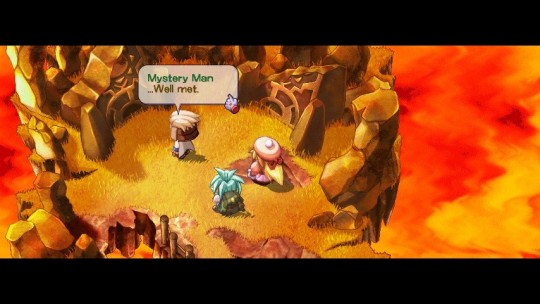
So what happens if you wait until after he’s unmasked himself, THEN hit up all the arcana paths in the dungeons?
Well, for one thing, his unmasking scene plays out quite a bit differently, since Pokkle and Pipiro will be meeting him for the very first time (a scene I had a lot of fun writing, particularly when Pipiro calls him “the living embodiment of stranger danger”). But then after that, when you proceed down the arcana paths, you’ll find no master awaiting you at all. Instead, you’ll simply find books! Books that give you electric shocks when you read them, teaching you the missing new arcana in the process (and leading to some pretty funny conversations between the two protagonists as they hold off touching the tingly tomes as long as possible, since they know just what’s coming when they finally give in – or rather, when Pokkle finally gives in, since Pipiro sure ain’t touchin’ that crap!).
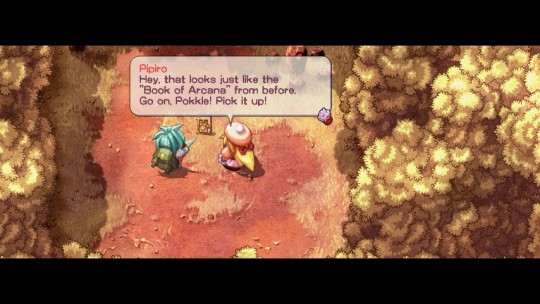
I love it when RPGs include that kind of attention to detail, and that’s really just one example of many. But there’s still more to discuss, too. Like the new stuff we added to fill in the gaps left behind by stuff we couldn’t quite include from the 2001 Japanese release.
See, in the original Japanese version of the game, there were three launcher apps you could unlock in addition to all the minigames: an alarm clock, a calculator, and a calendar. Matt (this game’s intrepid programmer, if you’ll recall) was originally going to port all three of these over into the final English version of the game, making them available to display on the HUD alongside the Pet Monitor, but he ran into some unexpected technical and logistical difficulties doing so. By the time he encountered these difficulties, he’d already successfully ported over the clock, but he was struggling with the calendar in particular.
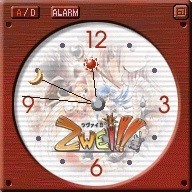
Behold the glory of the Zwei clock! Also available in digital form – just click that little “A/D” button.
This was when we realized, there’s not really any use whatsoever for a calendar or calculator in-game. Like, at all. I mean, I guess the same could be said of an alarm clock, but at least theoretically, if you’re playing the game in full-screen and you’ve got a hot date later or something, you could set yourself a reminder alarm for when you want to save and quit so you can get ready. (I dunno! It’s plausible, right? Right?!)
So the calendar and calculator were disabled. RIP, outdated desktop apps!
…Except, hold on. It turns out there’s actually an optional boss in the game that you can only get to by unlocking the clock, calendar, and calculator. Yes, seriously.
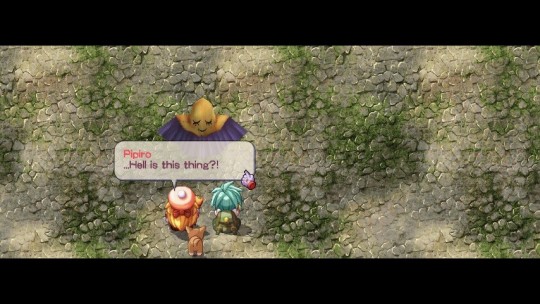
This means we had to replace the two missing apps with something else that could trip the same event flags. So I thought about it for a bit, and two new items were born: the “Clock Manual,” and the “Clock Warranty.” These two book items replace the calendar and calculator, and when used, they expand upon the lore of the clock (now the “Cursed Clock”), directly relating it back to the optional boss in question and giving tips on how and where to find him.
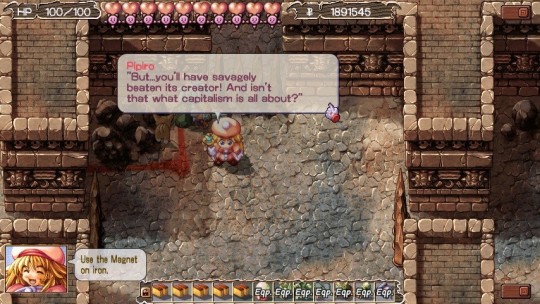
That’s not the only time we found that something in the game was more than meets the eye, though. Remember how in my previous blog, I said there was about two and a half games’ worth of text in the game’s files, including character backstories and plot arcs that were apparently cut from the final release? Well, some of that belonged to a hidden robot. And that particular text wasn’t quite as unused as I first thought.
We didn’t know this robot still existed in-game until we were deep into QA, but you have to find him in order to get one of the items necessary for 100% achievement completion on Steam or GOG Galaxy, so it was inevitable we’d come across him sooner or later. And while his original text unfortunately could not be included in the English version of the game as-is, the robot is still there, with a little bit of newly written text for your perusing enjoyment. And he still gives you one of the items you need in order to get all the achievements, so be sure to keep an eye out for him as you play! If you want to know where to find him… well, here’s a hint: this is the controller I switched to in order to accomplish the particular feat required to test his new dialogue.

You could say it met my… needs.
You may not have to do the same. You may be a far more accomplished gamer than I. But for me, this was the best option I had, and it worked like a charm. (Plus, it was IMMENSELY SATISFYING to play Zwei: AA and achieve something noteworthy using an MSX controller… but that may just be the MSX enthusiast/gaming hipster in me talking!)
Anyway, speaking of finding very well-hidden things, this game also has 16 collectible “bromides” in it. Remember the bromides from Lunar? Yeah, they’re kind of like that, only… less naughty.
In fact, in the original Japanese, they were MUCH less naughty. Because they didn’t do anything. They were literally just collectible items that took up space in your inventory. Catch ‘em all, and you got… the satisfaction of knowing you caught ‘em all! Which is fine, of course, and certainly not without precedent – I’ve played many other games that have had similar collection elements in them – but we thought it was a little bit of a shame to have these items in the game without giving the player a chance to actually look at them. So… we contracted the same artist who drew all our achievement icons for both Zwei titles to draw full-sized images for all 16 bromides as well.
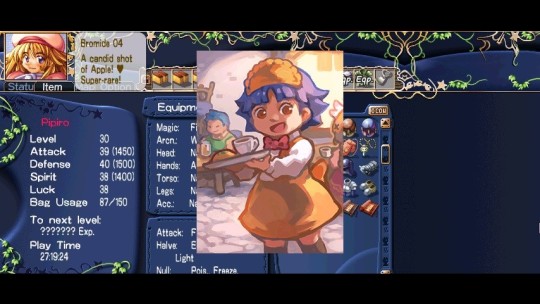
Yep. The bromide pictured here is one of the easier-to-find ones (though none are actually easy to find), but there are 15 more out there, just waiting to be seen! (And like this one, most of the others have secret cameos in them by characters from other Falcom titles, added with the full support and permission of Falcom themselves.)
We also hired an artist whom we’ve worked with in the past (on Ys: The Oath in FelghanaandYs Origin) to help expand some of the 4:3-resolution game areas and system screens to display in 16:9 without breaks in the art. Over time, his involvement grew, and he wound up designing a handful of tutorial images for us (since this game never previously had any in-game instructions or tutorials whatsoever, and is decidedly not intuitive enough to get away with that!). And boy oh boy, are these tutorials ever something special…
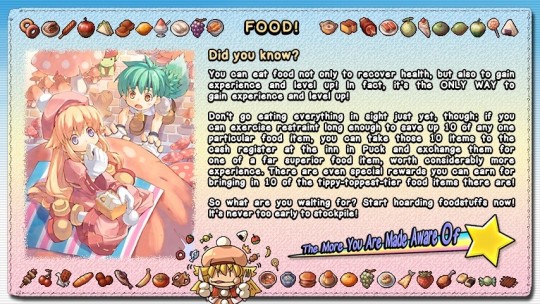
He also did a bunch of other stuff, including creating images for each of the status ailments, implementing virtually all our translated Japanese graphic text, and redoing the look of the arcade machines in “Undine Land” (you’ll find out about this place when you play) to better reflect the games contained within them.

Pretty nice, huh? Certainly makes The Typing of Ys feel a little more like it belongs in-universe!
So, yeah. This isn’t just a simple localization, nor is it really a port. It’s not quite an uprez, and it’s not quite a remake. It’s something altogether unique, and decidedly very special to us – to all of us who’ve involved ourselves with this game. It’s something we’ve poured our hearts and souls into, doing everything in our power to make it the best version of Zwei!! the world has ever seen, and to ensure you have a truly memorable and rewarding gaming experience when you play it. And we all hope very much that you do indeed love playing it as much as we loved working on it.
Be sure you don’t miss this one when it releases on January 24th.
(Oh, and check out the website, while you’re here. It’s pretty outstanding! Particularly that Characters section. Don’t think we’ve ever had something like that before on one of our sites, and it truly is something to behold!)
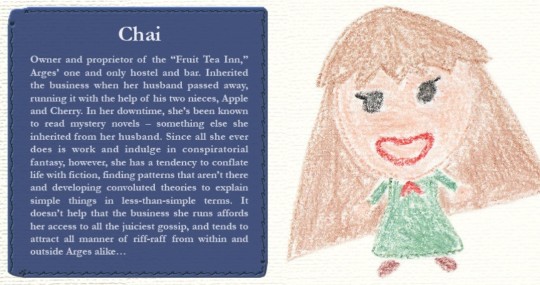
You can see the full roster at http://www.visitarges.com, along with a bevy of other information about the game!
Anyway, take care, future Zweiholics! May we meet again somewhere, someday, in the vast expanses of Granvallen!
Tom here again, for more fanboy gushing over Zwei: The Arges Adventure!
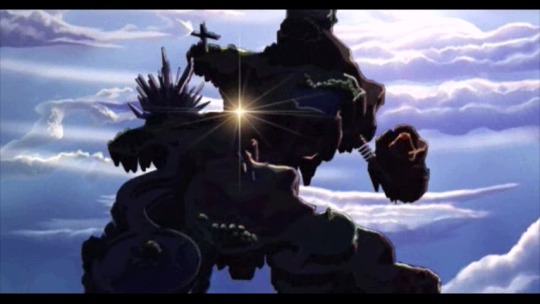
I’ve already touched on the game’s amazing script, and I’ll definitely go more into that in my next blog entry (there’s a lot to talk about there, as this is easily the strangest script I’ve ever worked with, on multiple levels!), but I figured I’d take this opportunity now to instead discuss some of the new and updated features that our amazing programmer was able to cram into this release. I’d rank most of these under the “quality-of-life improvements” category, though some are more along the lines of old but notable features from the original 2001 PC version which have been adapted to run more readily on modern systems and integrated more thoroughly into the game proper.
Note that in all cases (except where otherwise noted), the original functionality from the 2001 Japanese release still applies – there are just additional options now as well. Also note that while the additional options described all reference making use of controller buttons, allowances have been made for keyboard shortcuts that fulfill the same functions when applicable, so you keyboard-and-mouse gamers should reap some benefits of Matt’s coding prowess as well.
Anyway, let’s dive right in, shall we?
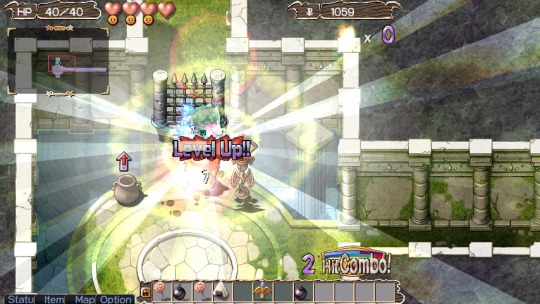
Feature: Quick-using food items in the heat of battle.
How it works in the 2001 Japanese release: In order to use an item, you first have to make sure it’s located on your hotbar (which has 12 available slots). Then, during gameplay, you have to either right-click the item with your mouse, or press the item’s corresponding function key (F1-F12) to use it. If you don’t want to drop your controller to use the mouse or keyboard for this task, no problem: there’s a button you can press that moves control of the game down to the hotbar, at which point you can press left and right to cycle through to the item you want, then press another button to use it. Afterward, you can press another combination of buttons to deselect the hotbar and return to regular gameplay. Time does NOT stop while you do this, however, so good luck surviving the enemy onslaught as you attempt to perform all these tasks!
How it works now: Just press one controller button to instantly use the left-most consumable healing item on your hotbar. After doing so, all other consumable healing items contained therein will shift left as far as they can go, ensuring that the slot you just freed up by using that one item is now located along the right side of the hotbar rather than the left. The reason for this? Well, when you pick up new items, they get sent to your hotbar first, as long as there’s space for them there. And if the blank slot on your hotbar happens to be all the way on the left, then whatever item you just picked up will end up being the first one you use next time you press the item button. But if the blank slot is on the right, whatever item you just picked up will be the LAST one in line for use – meaning, you can customize your own personal “eat list” that determines exactly what items you use on the fly, in exactly what order. Bit of an improvement, wouldn’t you say?

Feature: Switching magic/tools in the heat of battle.
How it works in the 2001 Japanese release: Your hotbar doubles as your equipment slots, so the only way to equip a magic jewel (which determines Pokkle and Pipiro’s attack type) or specialty tool (which allows for various puzzle-solving special abilities) is to add it to your hotbar, then “use” it (via one of the methods listed in my previous feature description), which places the Japanese equivalent of an “Eqp.” symbol over it, signifying that it is now equipped and ready to use. If you “use” that same hotbar slot again, you’ll unequip that item. And if you want to switch to a different magic jewel or tool… well, you either need to open your inventory, drag the new item onto the hotbar in place of the old one, then right-click it to equip it and close your inventory, or – alternately – just keep every equippable magic or tool you think you might be using in the near future on your hotbar (never mind all the food items this is preventing you from prepping!), and press the corresponding function key on your keyboard to equip it whenever the need arises. Siiiimple, right?
How it works now: Whatever your controller’s equivalent of the L1 and R1 buttons happen to be can now be used to cycle through all of your available magic and tools via a single hotbar slot. If you have no such item in your hotbar, but you’ve got one in your inventory, no problem: pressing L1 or R1 will automatically equip whatever you’ve got available into the first available hotbar slot. And from then on, you can just press L1 or R1 to instantly swap it out for whatever the previous or next equippable item in your inventory happens to be. Even unequipping your magic is part of the cycle, for those rare times when you’re attacking enemies who have resistance to all elementals, or when you’re attempting to solve puzzles that call for the use of Pipiro’s base magic.
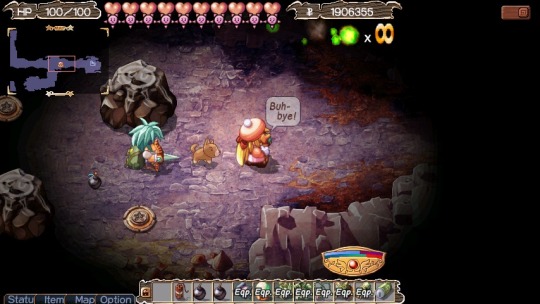
Feature: Dropping bombs or dynamite to blow up enemy artillery or large rocks.
How it works in the 2001 Japanese release: Oh, this one is really fun. Or rather, “fun.” In quotes. See, bombs and dynamite don’t work the same way as any other items. You can’t “use” either of them – attempting to do so will simply do nothing at all. Instead, you have to “discard” them. Using a mouse, this is accomplished via drag-and-drop; assuming there’s a bomb or piece of dynamite on your hotbar, you’ll need to click it and hold the mouse button, then drag it onto the main game screen somewhere and let go to drop it at that spot and set its 3-second fuse. This is made considerably tougher if you’re using a keyboard or controller, since you’ll have to press the button that transfers game control over to the hotbar, scroll over to the bomb or dynamite, press and hold the item-move button, then use the D-pad or arrow keys to move that item onto the main game screen, and finally let go of the button to drop the bomb/dynamite and set its 3-second fuse. But even after that, you’ll need to use the previously mentioned button combo to transfer control back over to your characters before you’re able to move out of the way of the explosion, which… doesn’t always happen in time. And worst of all, if you use any of these methods to attempt to drop a bomb or piece of dynamite, but the location you’re trying to drop it is considered invalid (maybe it’s a little too close to a wall, for example)… well, it’ll just cancel the whole operation and force you to do it all over again. There’s no mincing words here: using bombs and dynamite in the original version of this game suuuuuuuucks…
How it works now: Erm… you press the SELECT button. Basically, if you have at least one bomb or piece of dynamite on your hotbar, pressing the SELECT button will automatically drop it (or drop the left-most bomb or piece of dynamite, if you have multiples on your hotbar) at the closest valid location. That’s literally all there is to it!

Feature: Switching characters on the fly.
How it works in the 2001 Japanese release: There are three options. (1) You can click the character portrait on the bottom-left of the screen. (2) You can press the button to transfer control of the game to your hotbar, then move the cursor over to the portrait on the bottom-left of the screen and “click” it with the item-use button. (3) You can press the Esc key twice, though only if you’re standing still and… really, only if the game feels like honoring those keystrokes (it gets temperamental sometimes). Those are your options.
How it works now: …Yeah, uh, there’s a button for this now. In fact, since Zwei: The Ilvard Insurrection allows for two different control schemes (one button to attack, one button to switch characters; or, one button to switch to Ragna and perform a melee attack, one button to switch to Alwen and perform a magic attack), we decided to mirror that functionality in Zwei: The Arges Adventure with protagonists Pokkle and Pipiro. So whichever option you liked better in the other Zwei game, that option will be available to you here as well!
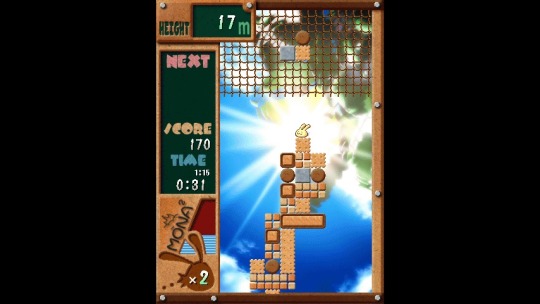
Feature:Playing the “Typing of Ys” and “Mona, Mona” minigames.
How it works in the 2001 Japanese release: These two minigames consist of an Ys-themed typing tutor and a reverse block puzzler (your goal is to avoid making combos at all costs, since you’re trying to build a sturdy block ladder so an infatuated bunny can climb to the top of the level and rendezvous with his true love). They’re pretty awesome. But they’re also a little… unusual in how they’re played. Basically, you have to unlock them in-game through special means, after which point you’re told that “something seems to have happened on the desktop.” Now you can play them whenever you want… from the launcher. You know, the window that pops up when you first boot the game, which allows you to adjust config settings and such? Yeah. You have to exit Zwei in order to play either of these minigames, because they’re only executable from that. They’re part of a small collection of what I’ve come to call “desktop apps,” which also include the likes of a clock, a calendar, and a calculator – all of which are usable ONLY from the launcher.
How it works now: First off, I should note that there is no launcher anymore in our English version of the game. At all. Matt doesn’t believe in launchers, and intends for every configuration option to be accessible and adjustable solely from within the game. So running these minigames from the launcher is simply no longer possible. But that’s okay! It’s kind of beside the point, in fact. The thing you really need to know here is that there’s a third notable minigame as well, called “Zwei Shooting.” It’s a classically styled shoot-em-up (also known as a “shmup,” if you’re rad), and it’s playable (in all Japanese versions of Zwei!! and in Zwei: The Arges Adventure alike) via an arcade cabinet in one specific town. This town has three other arcade cabinets right next to Zwei Shooting’s, but none of them actually have any games attached to them: one just shows you the instructions for Zwei Shooting, and the other two are literally just there for decoration. So we decided, why not assign the “Typing of Ys” and “Mona, Mona” minigames to two of the unused arcade cabinets? And while we were at it, we decided to make them playable right from the start, so as soon as you get to this town, you can play either (or both) of these minigames to your heart’s content! (Which means the conditions for unlocking them in the Japanese version now net you something else entirely, of course…)

Feature: Guiding your pet through dungeons and collecting items via the “Pet Monitor” app.
How it works in the 2001 Japanese release: Once again, this is a “desktop app” that you can run only via the game’s launcher, though this one is available anytime after you’ve acquired a pet in-game. This particular app, however, is largely passive, as your pet meanders through town and into dungeon areas, only occasionally reaching a crossroads or being forced to make some other binary decision (Go left, or go right? Fight the wildcat, or run away? Enter this new dungeon area, or go back home?). When the time comes to make one of these decisions, the pet will turn to face the camera, and you’ll be given the two possible options to select from. Mouse over the one you want (or wait a few seconds and let your pet make up its own mind), and then just keep on watching as the adventure unfolds. Your pet’s exploits can ultimately net it level-ups that will help it be a more effective AI companion during battle in the main game, or perhaps it can net you some extra food items to be used in your own adventures (which are transferred to the storage chest in Pokkle and Pipiro’s house next time you load a save-game).
How it works now: Once again, since there’s no launcher anymore, there’s no more Pet Monitor desktop app. What there is, however (and I’m going somewhere with this, I swear!), is the ability to leave your pet behind at Pokkle and Pipiro’s house as you go off on your journey. This option exists in the original Japanese version too, but there doesn’t seem to be any reason to ever make use of it – there’s never a time when leaving your pet at home would be more beneficial than bringing it with you. But now, it all makes sense! If you leave your pet behind, the Pet Monitor app will automatically appear as part of the HUD when you leave Puck Village, and it will remain on display (with the option to minimize it) the entire time you continue your adventure. So while you’re off fighting monsters and winning back your stolen macguffins, your pet is out somewhere in the same set of dungeons at the same time, finding treasure and fighting wildcats! And any time one of the Pet Monitor’s binary decisions appears on the screen, you may either mouse over the desired option to select it as before, or – if you’re in the heat of battle and can’t put your controller down, for instance – press the L2 or R2 button to select one of the two options without ever having to disrupt your flow. Finally, when you return to Puck Village, the Pet Monitor will automatically minimize as your pet hurries home to pretend like nothing ever happened. It’s the very model of efficiency, and adds a whole new level of meta-gaming to your journey!
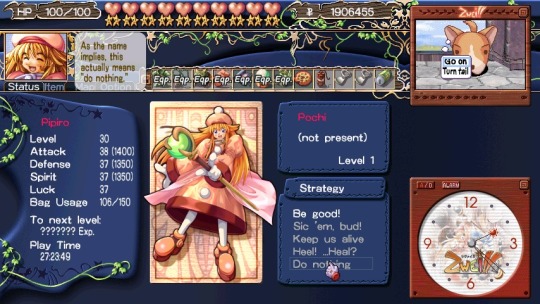
There’s plenty more to discuss, as there have been a bevy of other adjustments made as well (not just mainstays of PC production like widescreen support and achievements, but also simple yet welcome tweaks like the addition of a single button to open the inventory screen, or the streamlining of the game’s formerly rather cumbersome shop functionality). But this blog entry is already quite long, and some of the additions we’ve got on tap are directly tied to the game’s text in some manner… so those are stories best saved for next time around!
Until then, take care, and remember: if you tweeted about this blog entry on behalf of XSEED Games, chances are you Arges.*
…What can I say? When it comes to puns, I’m all about the low-hanging fruit, because it’s just so Ysy. So try not to Mona Mona too loud about it, and just keep on Monitoring this Tumblr for future updates!

Pipi, cheeri-ro!
*Note: This is actually not the case, as the person who Isges is currently off becoming a Mother 2.0. But the pun was deemed worthy of standing on its own merits, and has thus been left intact for your groaning enjoyment!
AAAAAAHHHHH IT’S FINALLY HAPPENING.
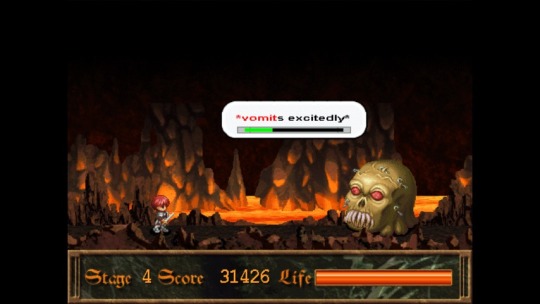
I’ve been working on this game for the better part of a year now, but have been unable to say anything about it for PR reasons – namely, that it wasn’t in a showable state, and we didn’t want to confuse prospective players by having two Zwei games announced but unreleased at the same time. Which is totally reasonable, but AAAAAAAHHHH I’VE BEEN WANTING TO TALK ABOUT THIS GAME SO BADLY YOU HAVE NO IDEA.
…Ahem. First off, I guess I should bring you all up to speed, in case you missed the announcement. Falcom’s 2001 PC classic Zwei!! is coming to the Western world via Steam, GOG, and The Humble Store in early 2018, under the name Zwei: The Arges Adventure. Why the name change? Well, because we already released its 2008 sequel, Zwei: The Ilvard Insurrection (which was originally called Zwei II: Sky-High Great Adventure in Japan).

That’s right. Localization work wrapped on the sequel first, and now we’re finishing things up with the original.
What are we thinking?!, you must be asking yourselves. Why would we release the sequel first, then go back and release the original? Why wouldn’t we release the original game first? And since we’ve already released the more modern second entry in the series from seven years later, can this earlier effort really hold its own by comparison?

Well, that’s why I’m so excited. Because Zwei: The Arges Adventure is good. REALLY good. In fact, I dare say it’s my favorite translation I’ve ever worked on to date – yes, even topping Return to PopoloCroisandCorpse Party. And if you’re at all familiar with me (this is Tom, BTW), that statement alone should tell you that Zwei: AA is something special, since PopoloCroisandCorpse Party are… shall we say, perennial favorites of mine. To put it very lightly.
So, yeah. Let’s address those hypothetical questions, shall we?

Why would we release the sequel before the original? Well, two reasons. One, because we can – these games each tell standalone stories, set on different floating continents with different casts of characters. Zwei: AA’s two protagonists, Pipiro and Pokkle, do make a few cameo appearances in Zwei: II, but this is done almost purely for the sake of fanservice (the literal kind, not the naughty kind). When all is said and done, these two games are completely standalone, taking place in the same world but telling very different stories with very different characters and a very different feel. Think of it kind of like the Ys series, but even more episodic (since, Ys Originaside,Ys has the Adol-as-protagonist connection from one game to the next, whereas Zwei doesn’t even have that!).
The other reason is because of the nature of Zwei: AA’s code. The Japanese version of this game utilized DirectX 5, was formatted strictly for 4:3 resolution with no widescreen options whatsoever, offered a lovely FPS selection of 30 or 15 (seriously!), counted on players to play it with mouse and keyboard over gamepad (it supported gamepads, but… barely), and contained no fewer than six unlockable Windows desktop apps that were loosely tied to yet completely separate from the main game.
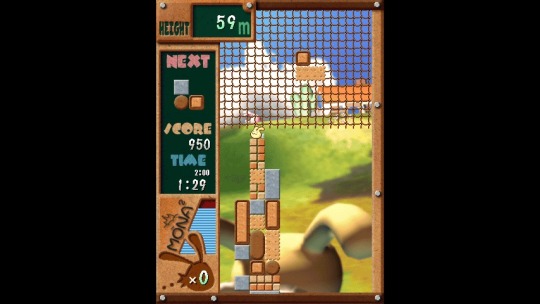
This is one of them. And that first screenshot at the beginning of this blog entry is another.
In other words… this is the kind of adaptive coding project that’s been known to give lesser programmers heart attacks. Getting a game like this to even run on a modern Windows machine at all – much less run WELL – was decidedly not a task for the meek. In fact, it’s because of the way this game is coded that we ultimately decided to translate the game in-house rather than working with any fan-translators as we did for Zwei: II, as no two programmers would handle this text the same way – and trying to convert a fan-translated script to a format that would work for us would’ve taken almost as long as translating the game from scratch.
So, yeah. Getting Zwei: II out first was pretty much just done because… erm… it was ready first. And it was always GOING to be ready first. Even with a lengthy QA process and a couple minor delays, it still inevitably got finished long before its predecessor was ready to make its debut.
Fortunately, we hired a veteran programmer to work with us on Zwei: AA… but you’ll never guess who! It wasn’t Sara, since she was busy getting Zwei: II ready at the time (and a fine job she did of it, with one of our smoothest PC launches ever!). But this wasn’t our first time working with the guy we worked with on this project, either. It was, however, our first time working with him to modernize someone else’s game – and he really did perform some miracles for us (and put up with my many, many demands for quality-of-life improvements and feature additions, to boot!).
The man in question? Matt Fielding, of Magnetic Realms. A.k.a. the guy who brought you the game Exile’s End.
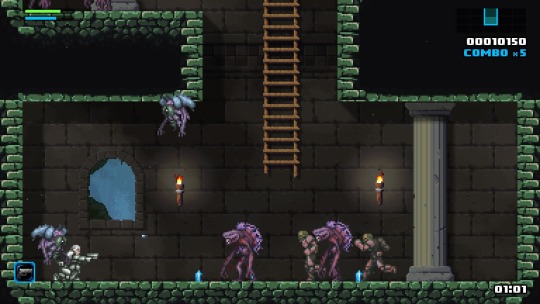
Pictured: Exile’s End. Which is also an awesome game you should play!
And thanks to his technical wizardry, you guys are going to have an astoundingly up-to-date version of Zwei!! on your hands at launch. We’re talking more than just widescreen support here – there’s full in-game integration of the Pet Monitor and other desktop apps, new control functionality for more natural gamepad support across the board, inclusion of the arranged soundtrack from the Japan-only PSP version of the game, additional art and text content not present in any previous version of the game, and much, much more (to be detailed in future blog entries!).

Moving on to the second question I asked, with Zwei: II already out, can Zwei: AA hold its own by comparison?
I think you know what my answer’s going to be, on that one. Zwei: The Arges Adventure is a freaking awesome game with a lot to offer, and differs from its own successor in enough key areas that it can very easily hold its own any day of the week. Hell, you might even like it better than Zwei: II – it’s certainly a very close call for me, but I’d say Zwei: AA gets the slight edge!
Sure, they’re both dungeon-crawling action RPGs at their core, and they both use food to level-up, even sharing the same food exchange system to discourage grinding. And the two-character party (plus one pet), with one character taking the role of physical attacker while the other slings spells, takes center stage in both titles as well. Plus, both games are set on floating continents in the same world.

That’s a lot of similarities, but they’re all relatively superficial. You could say Zwei: AA is like the 2D answer to Zwei: II’s 3D world, but that would be discounting its snarkier and more tongue-in-cheek storyline (yes, even more than Zwei: II’s!), or the gorgeous and ludicrously colorful hand-drawn backgrounds, or the two games’ very different approaches to pets (you only get one pet in Zwei: AA as opposed to the veritable army of pets featured in Zwei: II, but that one dog or cat [or other?] has significantly more personality and gameplay involvement than its many Zwei: II counterparts), or the huge variety of minigames on offer (all of which have been adapted to play from within the game itself, despite formerly existing only as desktop apps)… and that’s just scratching the surface. In short, although the two games use the same basic template, they represent two very different approaches to game design within the confines of that template.
For me as Zwei: AA’s translator, though, I can’t help but laser-focus right on the game’s dialogue. Protagonist duo Pipiro and Pokkle are without a doubt the best pair to write that somebody like me could ever ask for. Pokkle constantly cracks bad puns (and I do mean constantly!), wears a tail for funsies, and is always hitting on women twice his age.
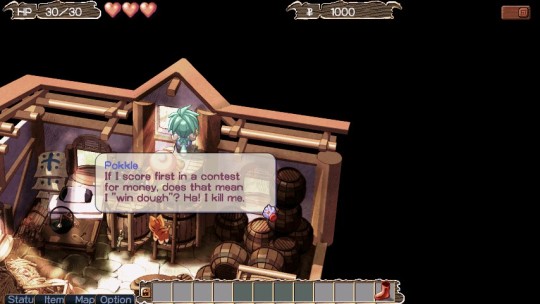
And Pipiro just has absolutely no filter whatsoever, and is full of so much snark that she’s fit to burst.
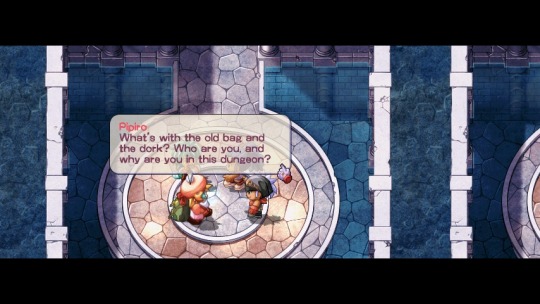
Practically every line out of these two is an absolute gem – and that’s to say nothing of the many quirky NPCs surrounding them over the course of their rather lengthy quest (such as the endlessly self-delusional “libertine fatass” that’s funding your adventure, and his extremely no-nonsense maid who gave him that nickname).

I… really can’t stress enough how much fun it was to write for these characters, and how inspired I was to come up with the perfect phrasing for every line. I’m extremely appreciative that we chose to translate the game in-house, as it gave me an opportunity to work much more deeply with this script than I ever could’ve if we’d only been tasked with editing it. As time went on, I found myself revising my work on a daily basis, making small tweaks here and there as new bits of wordplay or better puns popped into my head (much to Matt’s chagrin, I’m sure!). The end result is something that I can stand behind as a faithful interpretation of the game’s mood and intent – an attempt to convey the same degree of lighthearted fun and irreverence present in every line of the Japanese script, but formatted to sound more natural in English, accounting for context, tone, atmosphere, and individual character quirks rather than just hammering out a word-for-word translation.
I’ve never laughed so hard while playing a JRPG before, and I truly hope that when you guys play this one in English, you’ll find its English interpretation just as hilarious as I found its original Japanese to be. That would mean I succeeded at what I set out to do, and would bring me great joy and pride as a localizer!

And please do keep an eye on this Tumblr, as I fully intend to give lots more info about Zwei: The Arges Adventure (and more screenshots showing off lines I’m particularly proud of) in the weeks to come!
Until then, I hope you’re all continuing to enjoy Zwei: The Ilvard Insurrection, and… well, I’mma go back to testin’ Zwei: The Arges Adventure now, ‘cause I want this game to be downright perfect when it’s released! And with translation and editing 100% complete, and coding probably somewhere in the 70-80% done range, that release date will be here before you know it…
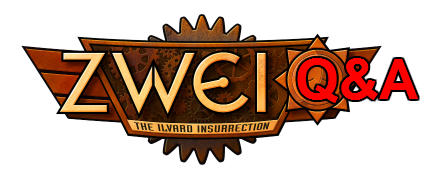
A very Zwei Q&A with editor Nick!
1) I’ve got a huge backlog of games. Why should I bump Zwei to the front of the queue?
It’s been a great year in videogames - perhaps TOO great, if my own backlog stack is any indication, and I have no doubt that many (most?) of you are in the same boat. But every now and then, we’ll get our hands on a game and it sort of effortlessly floats to the front of the queue, like it bought an expensive theme park pass. I’m under no illusion that Zwei will be “that game” for everyone, but for some of you, it might be! Let’s look at a couple reasons why Zwei: The Ilvard Insurrection might be just the game you’ve been looking for (but didn’t realize it)!
First, it’s got a great “medium” length. You won’t be rolling the credits in 10 hours, but it’s also not an 80+ hour bear where you just look at it and sigh and think, “I know I’ll love this, but…when will I find the time to play it?” With Zwei: II’s 30-ish hour average playtime, it offers a fulfilling action RPG experience you can sink your teeth into, but you won’t need to cancel all your plans for the next month to make time for it.
Second, Zwei represents a heretofore-unknown prong of Falcom’s action RPG legacy. Falcom is famous for Ys, an action RPG series that has spanned decades at this point, and other titles in a roughly similar vein, like Brandish and Xanadu - in fact, it’s been joked that Falcom’s “XYZ” is Xanadu, Ys, and Zwei. But unlike many of their other offerings, nothing from the Zwei series has ever been officially available outside Japan…until now. As Falcom’s last/most recent PC-exclusive title (made in 2008), it straddles a fun line between old-school charm and modern conveniences and storytelling. It’s the Falcom quality you know, but in a world distinctly different from their other games.
Third, Zwei is made to be easy to pick up and spend some time with without having to invest a ton of time in a sitting. Dungeons are generally broken up into discrete “branches,” each of which can be undertaken on its own, with save points in between and the ability to fast-travel between any save point you’ve been to at least once. If you’ve got 30 minutes, you can get something done in Zwei. If you’ve got an hour, you can do even more! The game reflects modern sensibilities regarding variances in player engagement and time commitment, and that makes it really easy to pick up whenever you feel like playing.
If any of that piques your interest, I’d invite you to consider bumping Zwei to the front of your gaming queue.

2) I love Falcom stuff like Ys and Trails, but this one seems…a little bit different. How does it compare? Will I like it?
As a Falcom action RPG, Zwei: The Ilvard Insurrection fits into a long legacy of storied games, and ultimately, as fans, we can’t help but draw comparisons. But I think overall, these are helpful comparisons to make, because in doing so, you can see where a game like Zwei 2 fits into Falcom’s growth as a developer over time.
The original Zwei was released in 2001. It’s more of a straight dungeon-crawler than its sequel, The Ilvard Insurrection, is, but it featured the mechanic that would go on to be the series’ calling card: two main characters, one specializing in melee attacks and one specializing in magic, who could be swapped between at any time with the tap of a button. However, Japanese fans would have to wait until 2008 to play the second game in the series.
Tom, our resident Falcom historian, slots the Zwei series into a gameplay lineage that also includes Gurumin (made in between the first and second Zwei games) and Nayuta no Kiseki (made after the second Zwei game). That separates it from the gameplay stylings of series like Ys or Xanadu, while still feeling pretty easy to get into for anyone who’s played those games before. Visually, Gurumin probably has the most “Zwei DNA” of any of Falcom’s other titles, as it features gameplay and even visuals that feel like they could easily have been part of a Zwei game.
The combat in Zwei is not as technical as in the Ys games - it takes more of a “big picture” approach, in the sense that often, your biggest advantages can be gained not in one’s mastery of controls or precise techniques, but in when you choose to swap between characters to chain their actions, and how you position yourself within spaces and relative to the enemies. Personally, I feel like this lends a bit more of an “arcade beat-em-up” feel to Zwei’s action RPG combat, so if that sounds like your kind of thing, well, get ready to grab your spoon and dig in.

3) I’ve heard Zwei: The Ilvard Insurrection has an unusual leveling system. What can you tell me about macaroni gratin and the power it bestows?
Well, macaroni gratin is delicious, and anyone who says otherwise is a just lookin’ to foment some dissent at the lunch tables. BRING IT.
…Er, what I mean to say is, the Zwei series’ leveling system is one of its most unique aspects. Instead of getting EXP from killing monsters, you gain EXP from eating food. This same food serves double duty as the main consumable items you use to heal yourself when you take damage, and you’ll get plenty of it as you go through the game. It might sound weird, but it works surprisingly well, and sets up some interesting scenarios. If you want to strongarm your way through dungeons, you can be more proactive about eating food to gain EXP and keep on par with or a little above each dungeon’s recommended level (as displayed by a metal plate on the floor before every dungeon branch). If you want to give yourself more of a challenge, you can use food only when you need to heal, and treat the EXP you gain as a residual bonus.
You can even just decide to enforce minimal food-usage (or not at all) and see how low of a level you can go through the game with, if you want to give yourself a real challenge. The game doesn’t have standard difficulty levels, but the way in which you use food sort of lets you scale the game’s difficulty as you see fit.
In addition, the game’s foods fit into four different “tiers,” and you can trade in ten of any one type of food for one of the “evolution” of that food in the next tier, with the higher-tier food giving 150% more EXP than 10 of the food that came before. It might sound confusing, but it’s really not. Here’s a quick example. I’ve got ten plates of Pasta Carbonara. Each one heals 28 HP and gives 2250 EXP when consumed. But, if I take those ten plates of Pasta Carbonara and trade ‘em in at the restaurant counter, I’ll get one plate of delicious Macaroni Gratin, which heals 38 HP (not a huge upgrade there), but gives a whopping 33,750 EXP when consumed. As you go further in the game, upgrading is more about maximizing your EXP gain versus raw healing amounts. If more raw healing is what you want, though, it may be worth NOT trading food up, because those ten plates of Pasta Carbonara can heal 280 HP - somewhere between two and three full life bars of health at high levels!

4) Got any advice for players? Must see or do stuff?
My best advice for players is to really think about the different types of magic Alwen has and what they’re good for. Some magic, like fire, is all about just blasting enemies and puttin’ the hurt on them. Other types of magic are, on their face, a bit weaker: ice launches only single shots that have a more limited range, wind whips up a small tornado that sweeps forward - but when you think about all the tools at your disposal, and especially how you can position or lock down enemies (known colloquially as “crowd control”), options that aren’t just MAXIMUM DAMAGE BAM RIGHT IN THE BACK OF THE HEAD WITH A FOLDING CHAIR really shine. In fact, if you decide to spelunk through the optional dungeon, you’ll need these strategies, because brute forcing your way will only take you so far.
Another piece of advice is to take the time to actually talk to NPCs. I admit, it’s a common thing to hear from a localization editor (“Please read this dialogue that I edited!”), but Zwei is a game with a very clear through-line, and if you want to, you can stay on that track, never really go places when it’s not necessary to, and finish the game with little trouble. But to do so would be denying yourself the chance to learn more about the amusing people who populate the game’s world. Taking a page from the Trails series, Zwei has NPCs who often change up what they say after both major and minor game events, and the NPCs have their own individual stories that develop as the game goes on. It’s worth your while to poke around and visit people, because there are many unique conversation snippets in the game that only play when you talk to someone at a particular phase of the game, and often there will even be differences in the dialogue depending on whether Ragna or Alwen is active as your lead character.

5) Since you’reknownfor your puns, give us your best shot. Which ones are you most proud of?
Surprisingly, Zwei: The Ilvard Insurrection isn’t particularly full of puns! Zwei: II’s style of humor leans much more toward pithy commentary and snarky asides, often made from one partner to the other in the middle of a conversation, or just “thought aloud.” Cheekiness seems to be a popular personality trait in the land of Ilvard, as the townsfolk and even the animals (…if you can talk with the animals) get in on the action. Pokkle, one half of the first Zwei game’s protagonist duo, is an inveterate punster, and while he does appear in this game in a cameo role, he’s not firing off puns left and right here. However…you can choose him as an opponent in the game’s battle arena, and if you select Ragna to fight him and win, upon being beaten, Pokkle will moan, “I just got Ragna-rocked!” It’s voiced, too, so enjoy that!

Service Penguin says thanks for reading, and be sure to check out the official Zwei: The Ilvard Insurrection site at: http://visitilvard.com/!
Zwei on STEAM!
Zwei on GOG!

Gadzooks, true believers! You don’t need to whip out your decoder rings to figure out that, in mere days, we’ll officially be in the autumn season. And I know what you’re thinking: “But Nick, you said Zwei: The Ilvard Insurrection was coming this summer, and as of right now, you’re just about out of summer!”
Alas, it’s true. You’re not going to see Zwei pop up on Steam without warning – both because there’s more I want to share before the game finally comes out, and because…well, letting you know in advance so you can plan/budget/spend accordingly is good policy. But most importantly, you’re not going to see it pop up because it’s not ready for release yet.

I’m not great at math and even I can tell there’s something iffy about those fractions.
At this moment, Zwei: II is in the middle of QA testing. We’ve got the game up and running: internally, Danielle, Nate, and I have played it through from beginning to end, and I’ve been busily making many tweaks and edits to the first-pass localization thanks to the helpful ability to see lines appearing in context. So on the “overall progress” front, we’re looking pretty good, actually.
And yet, to put it simply, there are some issues remaining that we wouldn’t feel comfortable releasing the game with and just patching later. Let me run down a couple of these with you to give you an idea of what I’m talking about.
1. If you watched our XSEED Livestream where I played Zwei, you might remember the unfortunate instance where I crashed out of the game because I got poisoned. Back then, we thought we’d gotten that one fixed, but it reared its head then, and is still crashing our games now. I found that this can be prevented by keeping the anti-poison accessory equipped whenever you’re in an area where there’s the possibility of being poisoned, but…you shouldn’t have to do that. It’s not supposed to be an anti-crashing accessory.
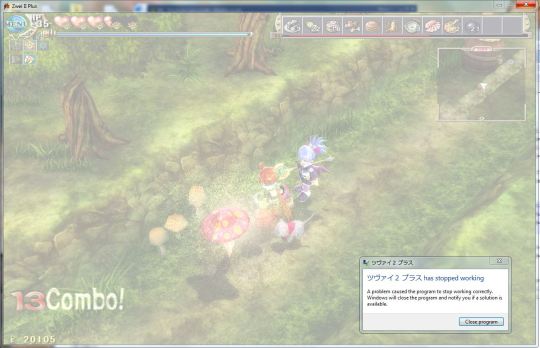
2. My top bugbear is that, within the game, there are places where the Japanese text for a line will display instead of the English. The first time I played through our English build, it happened almost never, but has since cropped up in other places – even in areas where I knew that text had been localized and easily located it in the files. We eventually had Sara do a game rip for the full text and Tom converted that to a file format similar to what I’d been working on all this time and inserting my localization back into it. In doing this, we found that some of the content – the bonus material in the “Zwei 2 Plus” Japanese release – wasn’t in our original script. That’s all been translated and localized now, and hopefully the new, easier-to-work-with file format will be a blanket fix for the Japanese text that was appearing.
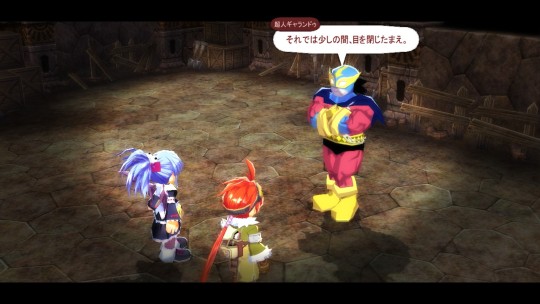
3. Since the game is releasing on Steam, I made achievements for it, because that’s something you do on Steam. It wasn’t originally designed with achievements in mind, though (it has its own internal “achievement system” in the form of gaining ranks in the Hunter’s Guild), so testing and making sure the achievements work as per their description is important, and also very time-consuming.
Because this is the first time I’ve actually had to create achievements from scratch (rather than just localize the Japanese achievements, as I did for the Trails of Cold Steel games), let me pause for a moment to expound on achievement design philosophy. In deciding what I wanted as achievements in Zwei: II, I wanted to cover a couple bases. I wanted several achievements that charted story progress, since the game is story-centric and people finishing the games they start is not a foregone conclusion and should be encouraged. Secondly, I wanted some achievements for collecting things, which involves more active exploration – like getting all the pets, or collecting every accessory. Third, I wanted a couple that were “hard,” in the sense that you had to do optional post-game stuff to get them, or that would be the result of more than one playthrough.
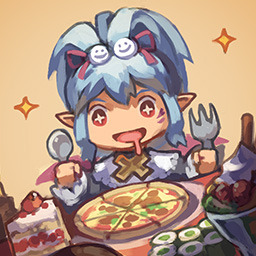
Feast your eyes on this cute achievement icon!
The tricky part here is that in this game, most of the things in a category will be fairly straightforward to obtain via progress, exploration, or money, but capstone things like the last pet, the very strongest armors (which also change Ragna and Alwen’s looks!), and the final Arcanum combo skill are gated behind doing optional content that’s a solid step up in difficulty from the base game. So what would ordinarily be a fun, reachable achievement like “Collect all the armors for Alwen” just becomes “do the optional dungeon” if we include those last “costume” armors, because you’ll get them as rewards for clearing different branches of that dungeon. And it’s redundant, too, because we already have an achievement for clearing all the branches of the bonus dungeon.
So the question is: do we treat those armors from the optional dungeon as…well, optional and make them not count for the purpose of the achievement? It’s a tough call, though I lean toward “yes, treat that stuff as optional” because there are already a couple achievements designed intentionally for players who want to be very thorough in their coverage and mastery of the game.

For a while, this floor just…wouldn’t load. You could jump off and you’d get stuck in an infinite loop of falling, taking damage each time your position “reset,” until you died and had to load from a save. Thankfully, we got the ground back under our feet.
But, to get back to the point, testing achievements is something we have to do for every game that has them, and adding them to a game that didn’t already have them adds an additional layer of complication to that. For example, let’s consider the game’s big bonus dungeon, the Illusory Labyrinth. It has four “branches,” each 20 floors long (but unconnected to the other branches), and there’s an achievement for clearing all branches. But when I cleared floor 20 of the first branch I ventured into, the achievement popped. So now, what we need to have the achievement do is clear, but then Sara, our programmer, has to decide whether it’s easier to have the achievement trigger off the completion of each floor, check your enemy log for the profiles of all the floor 20 bosses (probably the way I’d lean), or proc it based off the collection of all the final-floor rewards.
The good news is that we know what problems remain and, for the most part, they’re the kind of normal QA issues one would expect. The bad news is that we’re pushing Zwei: The Ilvard Insurrection’s release back into fall.
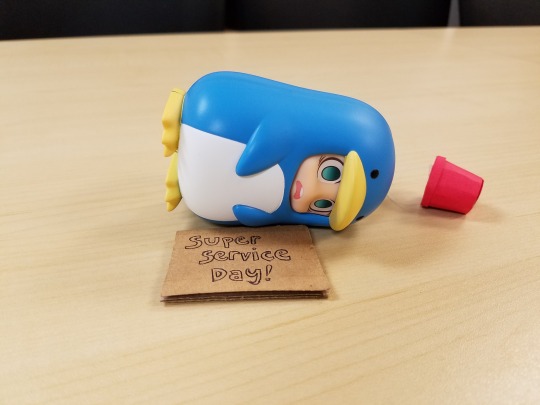
Summer just doesn’t seem to have worked out for us, does it?
Believe me, we’re not fond of game delays any more than you are. They’re disappointing, they let you down, and they’re awkward to announce. But, speaking personally, I’d rather wait for a game and have it work well from the get-go than play a game in a state where my immersion is interrupted by weird graphical or textual hiccups, or achievements popping at the wrong times. So that’s what we’re doing our best to deliver. Remember, every cake is gonna taste funny if it wasn’t baked long enough.
So…yeah. Kick back as the summer heat abates, grab yourself a pumpkin spice beverage, and wait warmly as we prepare for you a mighty fine video game that I think will prove worth the (additional) wait.
“Bring us Ys SEVEN on PC!”, the players said. “We want Ys SEVEN on PC!” The rallying cry echoed forth from all corners of the internet, and we knew it was only a matter of time before it echoed so loudly as to become almost deafening. Thus, we decided to silence the cries by giving the players what they wanted… and so Ys SEVEN PC came to pass, with its launch scheduled for August 30th (so soon!) on Steam, GOG, and the Humble Store by Humble Bundle.

But aside from a handful of screenshots and some emphatic assurances of quality, we’ve said and shown very little of this port, leaving you all to wonder, will it be any good?
Well, wonder no longer! I’m here to address all your concerns and assuage all your fears! So… let’s get right into it, shall we? We shall proceed in the tried-and-true form of the classic Q&A!
Q: Is this version of the game based on the Chinese PC port of Ys SEVEN from Joyoland?
A: No, it is not! This is a completely new port contracted by us. See my answer to the next question for more details.

Q: Is Durante porting this game?
A: No, he’s not. Nor is this a port from our regular programming guru, Sara. Due to the recent increase in the volume of PC titles we’ve been releasing, we’ve been forced to branch out and find new sources of programming wizardry to work with – and just as we’re very careful when selecting localization contractors to work with, we try to be very selective about whom we entrust with our partners’ code.
Since the particular group we’re working with for Ys SEVEN hasn’t yet come out and spoken of their involvement, we’ll respect their privacy and not name any names (you’ll be able to find out who it was soon enough when the game releases), but we will say this: these guys are GOOD. It’s a Japanese company that’s done extensive work on PC and console games alike, and they take a lot of pride in what they do.
Having never worked with this company before, we were initially wary (as we always are when working with somebody new for the first time), but they almost immediately proved themselves a true force to be reckoned with. The very first build of the game they sent us was basically a 100% playable port of the Japanese game from PSP to PC, complete with upscaled HD visuals and a 60 fps framerate. It looked great, played great, and ran perfectly on every one of our PCs. Plus, it was delivered to us much, much sooner than we expected.
And this was just a quick and dirty proof-of-concept build!
So if you’re worried about how the game will run on your system, or whether the port will even be any good… don’t be. These guys (who are apparently pretty big fans of the Ys series to begin with) clearly know their stuff, and have been an absolute joy to work with. We hope to employ their services again on future PC projects, and we hope you guys enjoy the fruits of their labor come August 30th.
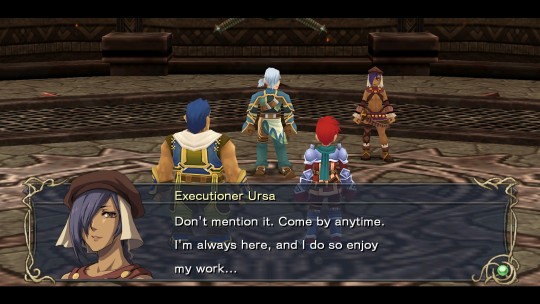
Q: Will the PC version of Ys SEVEN have all the same features Durante added to the PC version of The Legend of Heroes: Trails of Cold Steel?
A: Sadly, no, because most of those simply wouldn’t apply to Ys SEVEN. Remember, this is a game that was developed for the PSP, whereas Trails of Cold Steel was developed for the PS3. As such, there are limits to the visual enhancements that can be applied – without completely remaking the game from scratch, there will always be restrictions present here that you wouldn’t find in a game designed for HD visuals from the start. The most noticeable of these are the game’s textures, many of which don’t exist in high-res form. We experimented with upscaling these textures, but the results looked… less than ideal, and wound up highlighting other flaws (such as introducing very obvious texture seams and mismatches which are otherwise virtually unnoticeable).
Now, don’t go thinking this means the game will just look like a PSP title blown up to fill an HD screen! Far from it. Even if the textures are still rather lo-res in spots, the 3D models are all sharp as can be, with characters faring particularly well. There’s a lot more detail present on the characters now than ever before, helping to highlight their impressively fluid animations – and those animations look *especially* fluid at 60 fps!
But we do worry that those of you who’ve played Trails of Cold Steel PC might be a bit spoiled for choice after bearing witness to the sheer breadth of options available in that game’s admittedly brilliant launcher, so consider this a bit of advance notice: the launcher options for Ys SEVEN are far more basic, but the end result is a game that’s just as lovingly ported, and just as big an improvement over the original version. We feel that if you go into it with this caveat in mind, you’ll find yourself equally impressed with the end result.
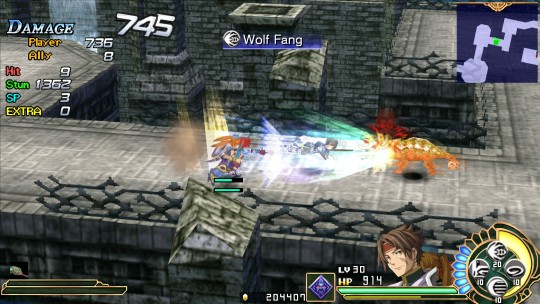
Q: What’s this I hear about the text being updated?
A: Yep! As long as we were working on this game anyway, we figured, why not make some improvements in the process?
See, Ys SEVEN was the very first editing project I ever worked on when I was hired as a Localization Specialist for XSEED Games over seven years ago… and I was hired near the end of the project’s production cycle, so I had precious little time to work on it. I had a lot of help from our esteemed former editor Jess (whom many of you may know as the sharer of blobfishes on our Twitter, among many other things), but the time constraints and my overall newness meant that my editing wasn’t all it could’ve been, and a lot of minor errors slipped through the cracks. In addition to typos and grammar errors here and there, there were even spots where I’d gotten the context of scenes wrong, as well as a general inconsistency in terminology and capitalization rules from one file to the next. It’s mostly stuff that wouldn’t be noticed by the average player, but I’m certain some of you language nerds like me who played Ys SEVEN on PSP must have cringed at least once or twice before its conclusion (and not just from my poor attempts at humorous interjections).
But all that changes now! …Or most of it, anyway. I’m sure we didn’t catch everything, and there are still plenty of issues with the text only filling up a small portion of the dialogue window in which it appears (this was tied to the text limits we were initially given when working on this game seven years ago, so it was a bit too universal to address across the board). But the fact is, we made changes to over a thousand lines of text – most just minor corrections to spelling, punctuation, or word order, but some consisting of complete rewrites for better clarity or more accuracy to the original Japanese – so we’re pretty confident in saying that any returning Ys fans who play this game should find themselves more immersed now from beginning to end than they were seven years ago, and new fans playing it for the first time will have the best possible experience doing so.
And I’ve gotta say, it feels good to have revisited this text and made some of the corrections I’ve been dying to make for the better part of a decade! It definitely adds a sense of closure to my beginnings at XSEED, and I hope you all are able to notice some of these differences and appreciate the hard work that the whole localization team put into them – because this wasn’t just me going back and fixing things, but all of us making a group effort to give this script a new lease on life. It’s like we all banded together for a common cause, and I couldn’t be prouder to have been a part of it. And even though the majority of our changes are so small that you may not even notice them, we believe that the subtle effect they’ll have on your ability to become engrossed in the game’s world will make all of our efforts totally worth it in the end!
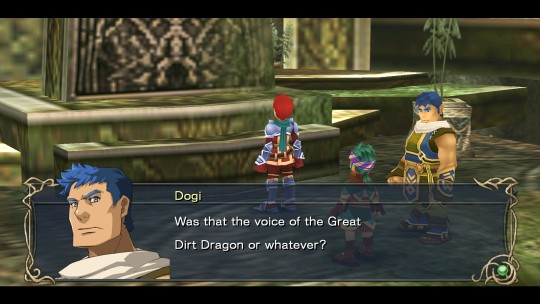
Q: Can we expect more ports like this in the future?
A: You’ll just have to wait and see! If we haven’t announced it, we can’t say anything about it. But that doesn’t mean we don’t have things in the works behind the scenes!
* * *
So, did I miss anything? If you have any further questions, feel free to pose them on our Facebook or Twitter – or on our forums at www.xseedgames.com if you want to reach out to me directly, since the forums are my usual stomping grounds.
And come August 30th (my birthday!), I hope you all have an awesome time with Ys SEVEN. As of today, it’s been exactly seven years since our initial release of the game, and while we weren’t quite able to time the release of the PC version so it fell on the same day, we’re thrilled we can bring this wonderful game (one of my personal favorites in the whole series) to a wider audience, and we hope to hear nothing but good things from you guys as you sink your teeth into it in two weeks.
Please enjoy your time in the land of Altago, everyone!
-Tom

~Feena~ (WIP)
A Trails of Cold Steel + Granblue Fantasy crossover commission! May there one day be a real event with these two game series’ together, kicking butt with weapons and every colour of magic.
Zoomies and Sketches on my Instagram: https://www.instagram.com/p/CNsbJR4DbRl/?utm_source=ig_web_copy_link
Post link







